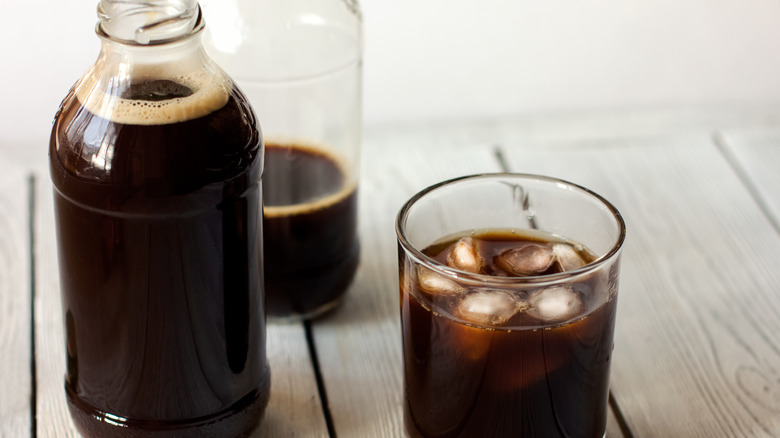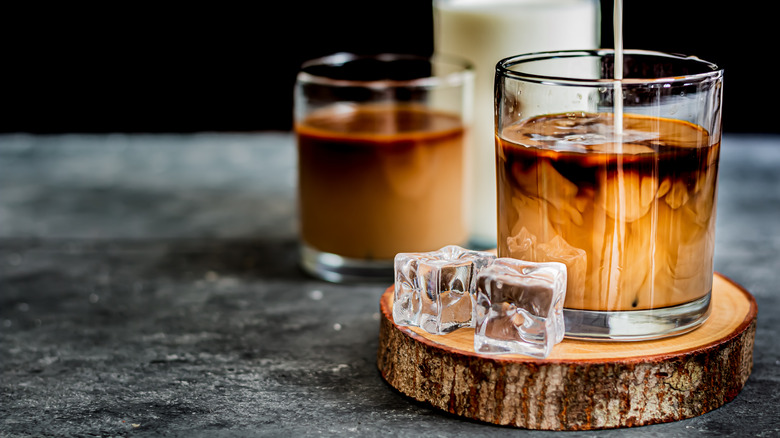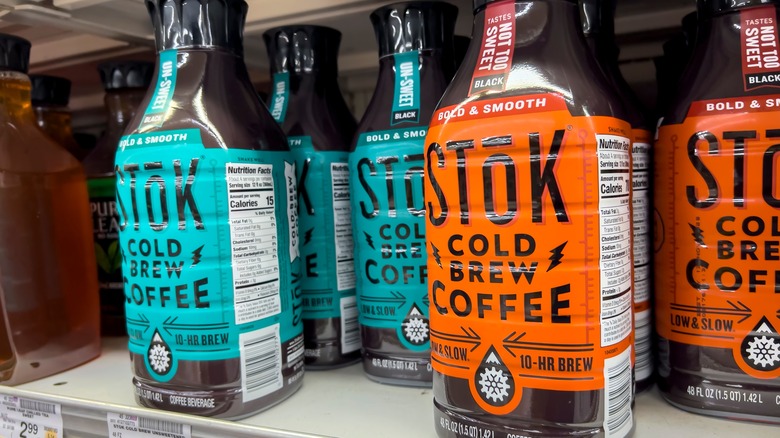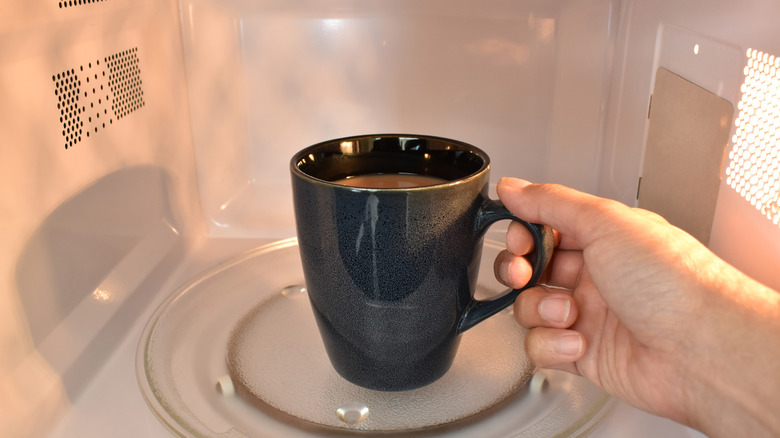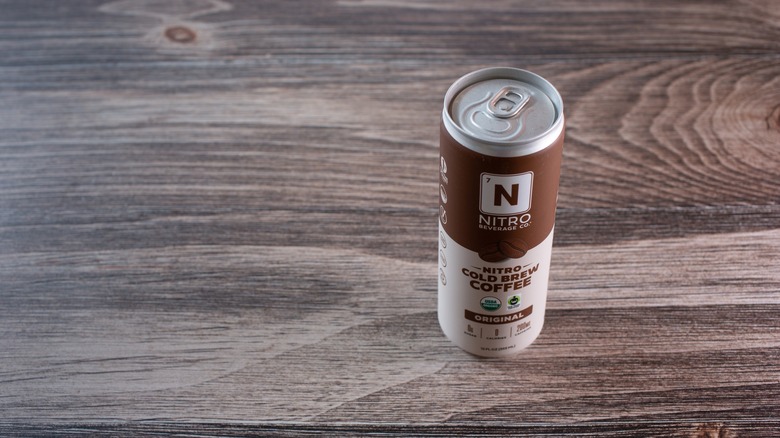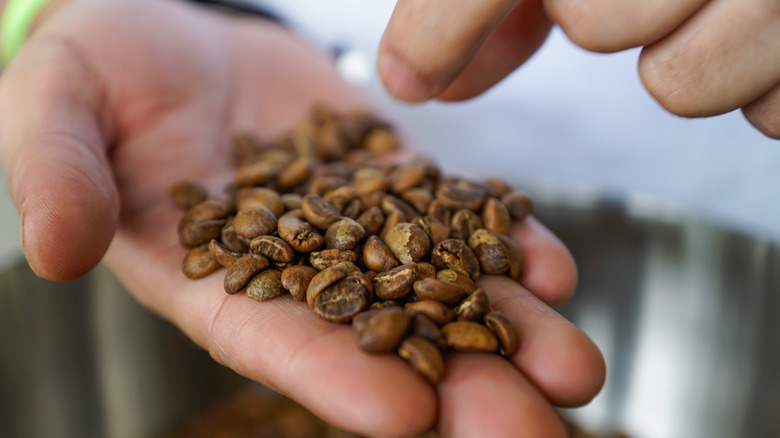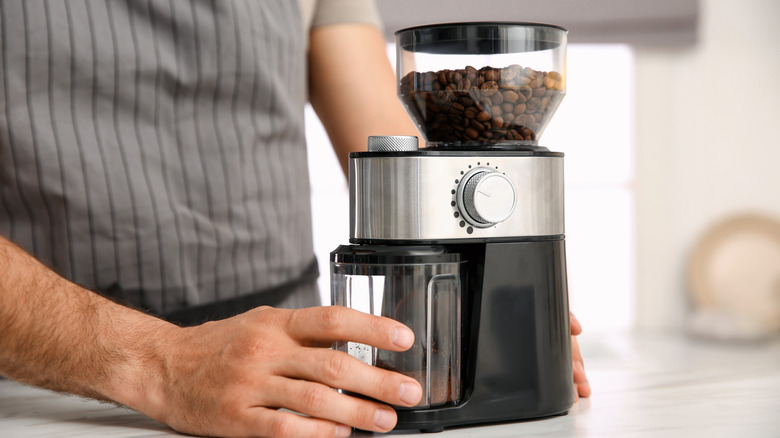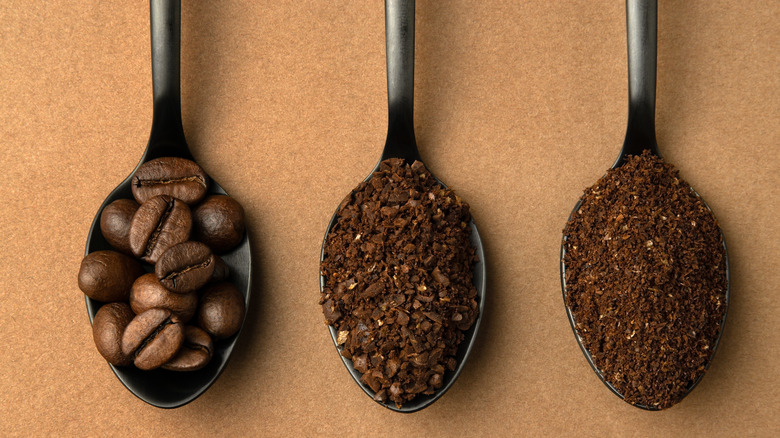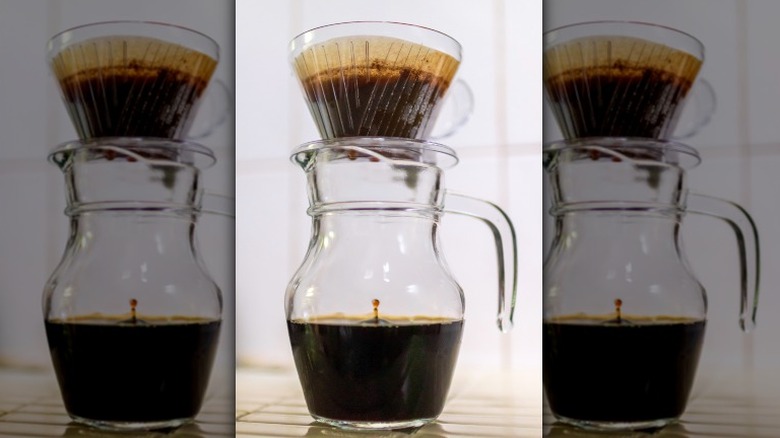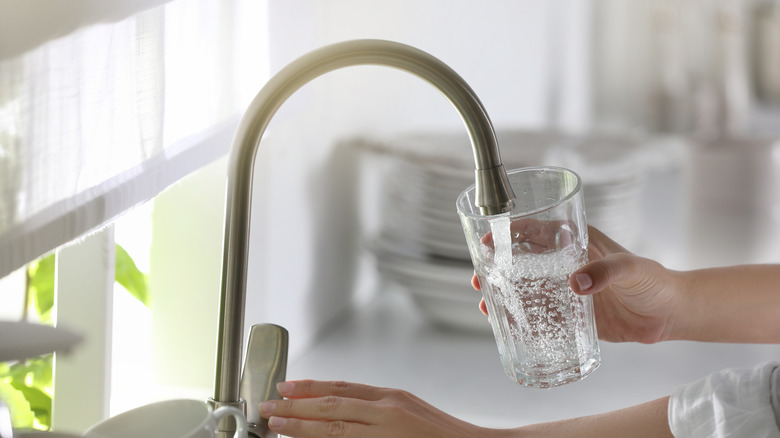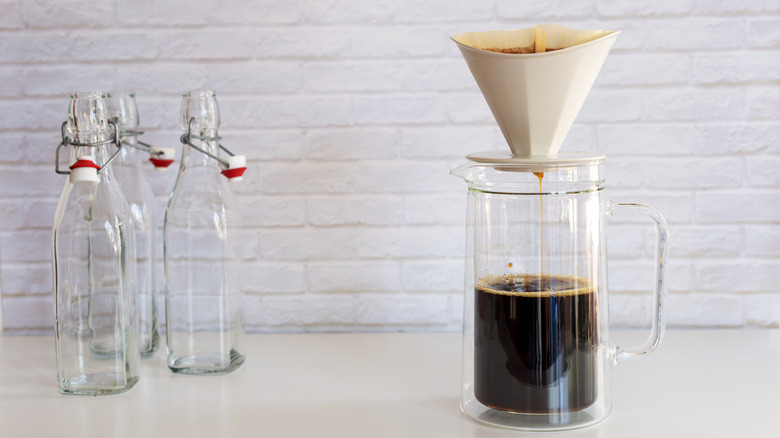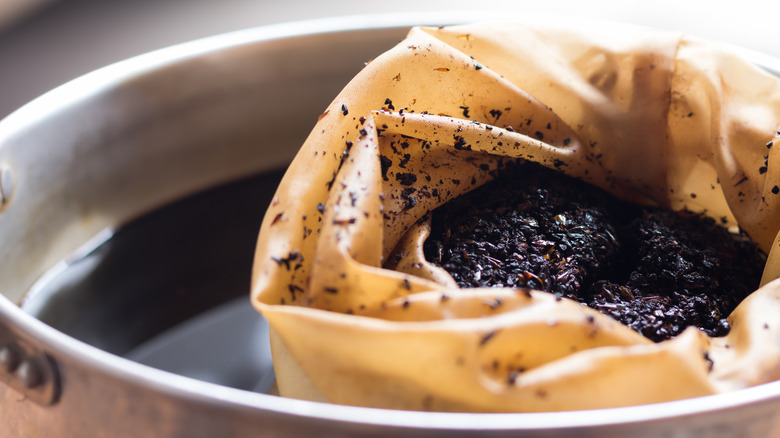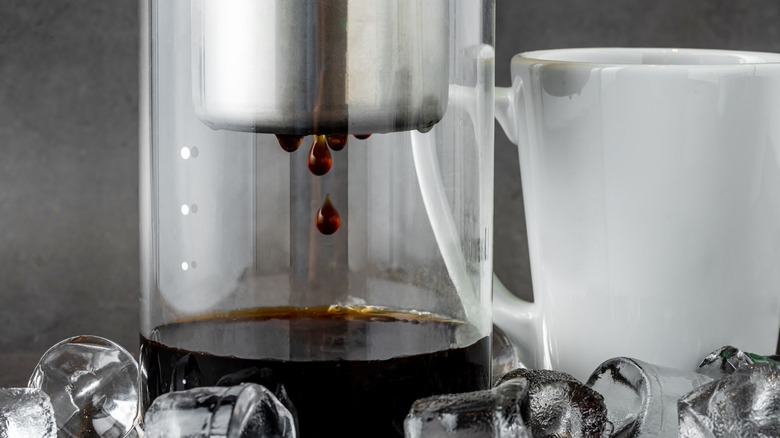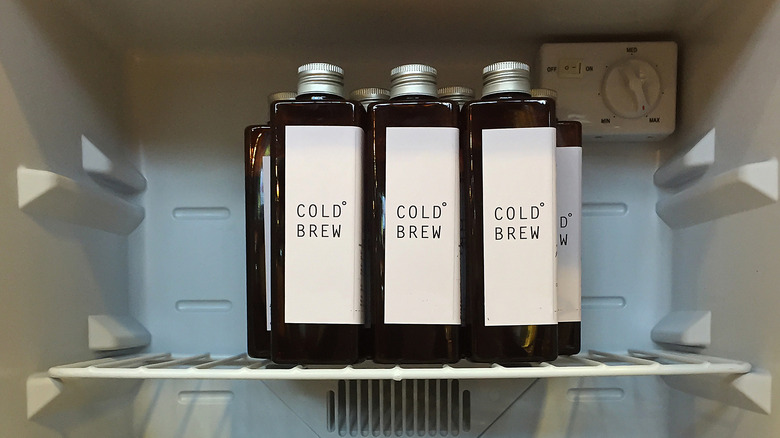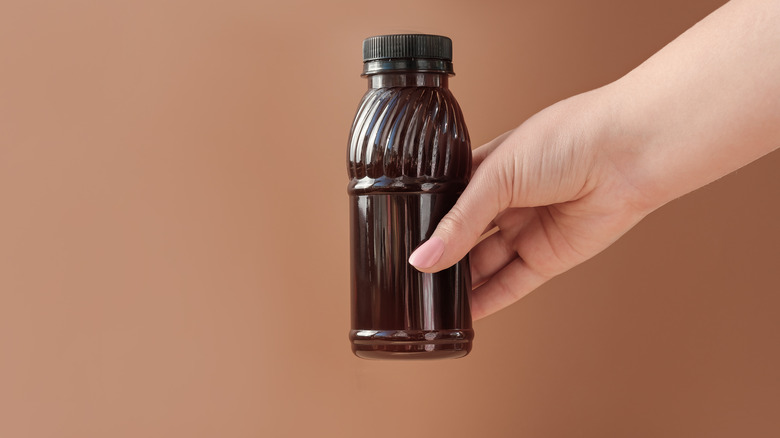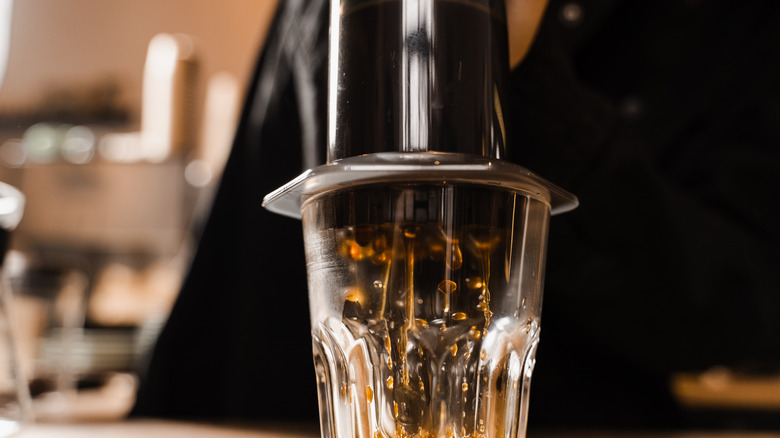15 Mistakes You're Making With Cold Brew Coffee
Hot, iced, or cold brew — there's no wrong way to start your morning off. We would, however, like to argue that the best way is with cold brew coffee. Cold brew is a refreshing coffee beverage that can be crafted to include your favorite coffee creamers and flavorings. In addition, many people prefer drinking cold brew because of its low acid levels, which impart a sweeter, mild tone with less bitter notes.
While cold brew is a product widely available in large bottles in grocery stores or single-serve cans for on-the-go sipping, many folks choose to make their cold brew at home to cut costs. But with the exorbitant cost of coffee and the extended period of time that it takes to make your perfect brew, you'll want to make sure you're making your cold brew coffee the best (and most efficient way possible). We spoke with Leon Grodski Barrera, co-owner of Little Waves Coffee Roasters in Durham, North Carolina, to help share some of the most common mistakes people make with cold brew and how to fix them.
Confusing cold brew and iced coffee
The first big mistake people make with cold brew is confusing it with iced coffee. Although yes, cold brew can be served with ice, it is prepared differently than iced coffee. Iced coffee, unlike cold brew, is made by brewing hot coffee over ice. Most coffee shops will take day-old hot coffee and put it in the refrigerator to allow it to chill overnight to make iced coffee. Iced coffee is typically cheaper to purchase ready-to-drink because it can be more readily made. Cold brew, by comparison, takes much more time to infuse. To make a cold brew, a barista steeps the coffee beans directly with cold water instead of doing a pour-over. Then, the coffee is drained out and served chilled.
Since there is no hot element with cold brew coffee, the beans retain their sweet and aromatic compounds. The resulting brew is much less acidic and milder in flavor than iced coffee. If you like the taste of black coffee but don't like its acidity, you can try drinking cold brew coffee instead.
Choosing the wrong pre-made cold brew
The market demand for cold brew coffee has increased exponentially in recent years and caused brands to release a diversity of products to satisfy consumers' cold brew itch. Some of our favorite cold brew coffee brands include Bizzy Coffee, which offers around 180 to 220 milligrams of caffeine per cup and several mild, well-rounded flavor options for customers to choose from. If your house (or office goes through a lot of cold brew), you may consider choosing Wandering Bear cold brew boxes in 96-ounce or gallon containers.
Our least favorite cold brew brands we reviewed included Chobani — which we thought tasted more like straight coffee creamer than coffee — and the lackluster-flavored Califia Farms cold brew bottles. If you're planning on buying cold brew, we recommend first researching the cost and quality comparison of different cold brew brands. In short, it's too expensive not to like what you're drinking.
Leaving your cold brew at room temperature
Some people can tolerate lukewarm coffee. How? We don't know.
Cold brew coffee is meant to be consumed cold rather than warm. Leaving your (black, with no perishable creamer) cold brew coffee out at room temperature can reduce its shelf life significantly, from two weeks in the fridge to two days on the counter. And while leaving cold brew coffee at room temperature may not make you sick, drinking room temperature cold brew can allow some unpalatable flavors to emerge. This is because cold brew, like all products, is prone to oxidation. The oxygen will change the coffee's flavor and color over time and can lead to mold, unpleasant odors, or a prominent stale taste. If you take too long to drink your cold brew, you can try brewing it in smaller batches. You should also always leave your cold brew in the fridge until you're ready to drink it and watch out for signs that your coffee needs to get tossed out.
Not shaking your nitro can
Along with the surge in the popularity of cold brew coffee came an obsession with nitro cold brew coffee. Nitro cold brew has undergone the same brewing process as traditional cold brew coffee but has been infused with nitrogen gas. The bubbliness of the nitrogen imparts a creamy flavor and silky texture that replaces the need for dairy and added milk in the beverage.
Luckily, you won't have to go to your local Starbucks or an artisan coffee shop to get your hands on a nitro cold brew coffee. You can order single-serving cans from many online retailers. The first important step for drinking nitro-infused cold brew is always shaking the can and pouring it quickly. Since the nitrogen bubbles are smaller than carbon dioxide (like in a soda), there is minimal risk of over-shaking and subsequent explosion. Shaking the nitro can is important because it moves the nitrogen bubbles around and produces a foamier texture. You should also avoid serving your beverage over ice because it will further disrupt the foaminess.
Using a bean that is too acidic
If you're dead set on making your own cold brew at home, you need to start with good beans. According to Leon Grodski Barrera, most cold brew enthusiasts are looking for a low-acid roast on their coffee. For their in-house cold brew, Little Waves Coffee Roasters uses a blend of two Mexican-origin coffees for a mild flavor with a chocolatey undertone, but Leon also notes that several brewers will also use single-origin East African coffee for a brighter taste to their cold brew.
If you're looking for a low-acid bean, you're likely looking for a medium or a dark roast. Light roasts, like blonde roasts, tend to have more acidic flavors muddled by the cold brewing technique. On the other hand, medium or dark roast coffee tends to have deeper flavor notes that shine through well with a cold brew, but as Leon notes, the choice of coffee is always subjective and dependent on the desired taste profile.
Picking the wrong grinder
There are two options for grinding coffee beans for cold brewing. You can either purchase pre-ground beans or use your own grinder at home. If you don't have access to a grinder, you can buy pre-grounds, but you must sacrifice the flavor and freshness of your brew. Grinding the beans increases the surface area exposed to oxidation; ground coffee can lose its optimal flavor within half an hour of grinding. Since grind size is very important when it comes to cold brew, grinding your own beans at home gives you much more control over your grind size.
If you're looking to purchase a grinder, Grodski Barrera recommends buying the Baratza Encore Grinder. It's priced competitively at under $200, has 40 different grind settings, and holds up to 8 ounces of coffee in its hopper. The versatility of this grinder allows you to use it for all of your different coffee brewing methods.
Grinding your beans too finely
Leon Grodski Barrera notes that the type of grinder is not as crucial as the grind size when it comes to cold brew. You should always grind cold brew beans similar to the consistency of table salt. On most machines, this is described as a medium-coarse grind, which is coarser than you would use for a pour-over coffee.
The reason medium coarse is the absolute best grind size for cold brew coffee is that the lower surface area of coarse ground coffee slows the extraction rate from the beans. Espresso, for example, has a much finer grind size because it allows the water to percolate through and extract the flavor of the beans quickly. If you used a fine grind size for a cold brew coffee, you'd find that the flavors are over-extracted and rather bitter. It's better to err on the side of caution and have coffee beans that are ground coarse rather than ground too finely.
Not paying attention to your brew ratio
Any coffee barista should be able to tell you the importance of a brew ratio. The brew ratio is the number of coffee grounds compared to the amount of water used to make coffee. Leon Grodski Barrera recommends using a 1-to-8 ratio of coffee to water for a double-strength concentrate and then diluting it down using a concentrate-to-filtered water ratio of 1-to-1. This will give you the least caffeinated, most mild-tasting cold brew. If you prefer a stronger concentrate, you can use a 1-to-4 ratio of coffee to water and then dilute it down with a coffee-to-water ratio of 1-to-2. You don't just have to use water to dilute your mixture; Leon also recommends trying to make your concentrate latte-style with a 1-to-1 ratio of milk.
Grodski Barrera notes that although these brewing guidelines are mostly reliable, there are potentially some mitigating factors, like grind size, steeping time, and the amount of time between roasting and grinding, that will affect the flavor. He recommends playing around with the "recipe" for cold brew to find the right one that works for you.
Using any type of water to brew your coffee
Who knew coffee was so finicky? Leon Grodski Barrera explains that the type of water you use for any coffee affects its extraction. "To simplify things, it is important to have between 75 and 130 parts per million solubles in one's water because the coffee needs solubles or mineral content to adhere to," he notes. These solubles can include calcium and magnesium. Water that is free of these solubles can do more damage to the equipment and even act corrosive; this is why distilled water is never recommended for brewing coffee.
Grodski Barrera notes that the exact water care you'll need to perform for optimal cold brewing depends on the region of the country you live in. For most people, using filtered water will be the best course of action. The filter removes some harsh, flavor-altering substances like chlorine and sediment but leaves the minerals that the coffee needs for optimal extraction.
Pouring out your coffee prematurely
Once you have your beans and your water ready, it's time to start brewing. Your cold brew setup depends on the tools and technology you're using. Some cold brew setups are as simple as a mason jar filled with beans and water, while others, like the popular Toddy system, use a drip design to strain the coffee from the brewing container to the decanter.
It is important to remember that when making a cold brew, you'll need to allocate upwards of 12 to 20 hours for your cold brew to infuse properly. Stopping the cold brew process before this time is reached will result in a weaker flavor and poor extraction from your beans — which often manifests as a sour taste. Hot coffee takes under half an hour to brew because the heat does much of the extraction work. Cold brew, in comparison, draws out the flavor more gradually.
Leaving the beans in the water for too long
Although you might be inclined to leave your cold brew to steep for several days (seriously, the mason jar just gets lost in the back of your fridge sometimes), there is a cap at which your coffee has become too over-extracted. Leon Grodski Barrera caps the brewing time for his cold brew at 20 hours. Other cold brew recipes note that the coffee should be removed from the beans within 24 hours.
The trick to knowing if your coffee is over-extracted is straightforward, Grodski Barrera shares. "The easiest way to taste over-extraction is to pay attention to the mid-back part of your tongue. While over-extraction creates bitterness, I find it easiest to identify regarding brewing by paying attention to that area of the tongue; if you feel a kind of poky fingernail on the tongue feeling, along with a sticky dryness, that's usually a sign of over-extraction," notes Barrera.
Only filtering the coffee once
Everyone has experienced gritty-tasting coffee before in their lifetime. Cold brew coffee is no exception. At Little Waves Coffee Roasters, the coffee is drained once, then re-drained through a paper filter to help remove the smaller bean particulates left over in the coffee. You should also avoid rushing the straining and pressing process to ensure that your coffee has the fullest flavor possible. To avoid this big mistake with cold brew, try allowing the straining to work by itself via gravity — no prodding needed. If you're working in big batches, try to separate and work with smaller servings to ensure none of the coffee grit gets missed.
One of the ways you can reduce the number of particulates in your coffee is always to use a coarse grind. However, if you grind too finely, sneaky little flecks of coffee will make their way into your finished beverage.
Waiting too long to drink your cold brew
Even good things don't last forever. Leon Grodski Barrera notes that the peak flavor of a cold brew coffee is within the first three to four days after brewing. He claims that a week is usually the longest that home-brewed coffee can last, but may not show obvious signs of spoilage until two weeks after brewing.
If you've made a cold brew concentrate, you should store it as the concentrate rather than diluting it. For optimal freshness, you should keep your cold brew in an air-tight container to minimize oxidation. Glass containers are the most preferable for storage because they are relatively easy to seal, and the glass will not impart any flavors on the coffee. Plastic can be porous and impart unpleasant flavors to the coffee, while metal can change the taste of the coffee. The coffee's acidity can also degrade the metal storage container, making it a less preferable option.
Only making ready-to-drink cold brew
If you've gone to the store, you may have seen small containers of cold brew concentrate on the shelves. However, cold brew concentrate may be a more feasible option for folks that drink a lot of cold brew because you can have the same flavor without making a ton of it. Instead, you can just pop the top off a concentrate, add your desired amount of water or milk, and drink up. Little Waves Coffee Roasters uses the 1-to-4 ratio of grounds to water for a cold brew concentrate.
If you are new to cold brew concentrates, many products are available at our favorite grocery store: Trader Joe's. We recommend trying Trader Joe's Organic Cold Brew coffee. This glass-bottled coffee is steeped for 20 hours before being mixed with espresso and infused with nitrogen for a strong flavor. If you want to stick with a concentrate, you can't go wrong with their cold brew coffee concentrate, which is priced competitively at $0.28 per ounce at the time of publication.
Making cold brew espresso
Some folks argue that making cold brew espresso is possible, but Grodski Barrera is not one of them. By definition, espresso uses pressure to extract the flavor compounds from the coffee and requires a fine ground size. The "cold brew espresso" technique uses a manual espresso maker, like an Aeropress, and extra-fine grounds that are quickly pressed with cold water to avoid over-extraction. However, this takes away from the fundamental definitions of both "cold brew" (which uses a coarse grind and cold water over a long extraction time) and the "espresso" (which uses a fine grind, hot water, and rapid extraction). "We love Aeropresses, and you can create a great concentrate on them," he notes, "but we would not call it espresso."
Grodski Barrera notes that although cold brew espresso might be a stretch, there are some things you can do to make a cold brew version of espresso. Grodski Barrera recommends pouring the cold brew concentrate into shot glasses and treating it like an espresso shot, or making cold brew concentrate ice cubes to dissolve in your favorite milk or cream.
Static Media owns and operates Tasting Table and Mashed.
